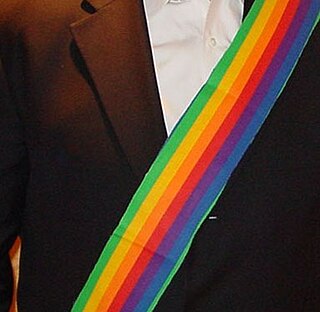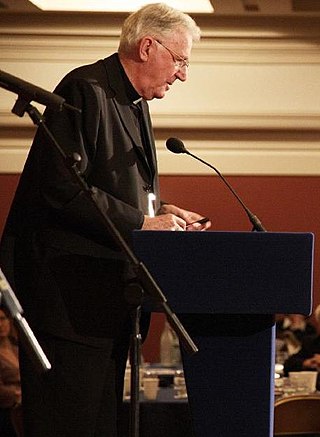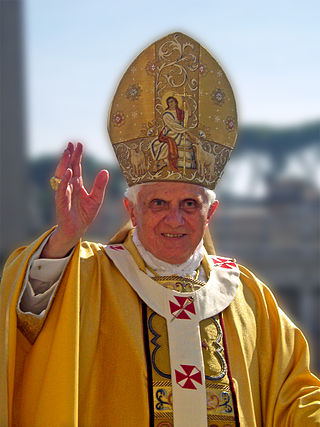
John Joseph O'Connor was an American prelate of the Catholic Church. He served as Archbishop of New York from 1984 until his death in 2000, and was made a cardinal in 1985. He previously served as a U.S. Navy chaplain (1952–1979, including four years as Chief, auxiliary bishop of the Military Vicariate of the United States, and Bishop of Scranton in Pennsylvania.

Edward Michael Egan was an American cardinal of the Catholic Church. He served as bishop of the Diocese of Bridgeport in Connecticut from 1988 to 2000 and as archbishop of the Archdiocese of New York in New York City from 2000 to 2009. He was elevated to the cardinalate in 2001.

AIDS Coalition to Unleash Power is an international, grassroots political group working to end the AIDS pandemic. The group works to improve the lives of people with AIDS through direct action, medical research, treatment and advocacy, and working to change legislation and public policies.

Host desecration is a form of sacrilege in Christian denominations that follow the doctrine of the real presence of Christ in the Eucharist. It involves the mistreatment or malicious use of a consecrated host—the bread used in the Eucharistic service of the Divine Liturgy or Mass. It is forbidden by the Catholic, Oriental Orthodox, and Eastern Orthodox Churches, as well as in certain Protestant traditions. In Catholicism, where the host is held to have been transubstantiated into the body of Jesus Christ, host desecration is one of the gravest sins. Intentional host desecration incurs the penalty of excommunication latae sententiae. Throughout history, a number of groups have been accused of desecrating the Eucharist, often with grave consequences due to the spiritual importance of the consecrated host.
This is a list of notable events in the history of LGBT rights that took place in the year 1989.

Open communion is the practice of some Protestant Churches of allowing members and non-members to receive the Eucharist. Many but not all churches that practice open communion require that the person receiving communion be a baptized Christian, and other requirements may apply as well. In Methodism, open communion is referred to as the open table, meaning that all may approach the Communion table.

The Rainbow Sash Movement is an organisation of gay, lesbian, bisexual, and transgender Catholics, with their families and friends, who are publicly calling the Catholic Church to a "conversion of heart around issues of human sexuality".

Cormac Murphy-O'Connor was a British cardinal, the Archbishop of Westminster and president of the Catholic Bishops' Conference of England and Wales. He was made cardinal by Pope John Paul II in 2001. He submitted his resignation as archbishop on reaching his 75th birthday in 2007; Pope Benedict XVI accepted it on 3 April 2009.

Sacramental bread, also called Communion bread, Communion wafer, Sacred host, Eucharistic bread, the Lamb or simply the host, is the bread used in the Christian ritual of the Eucharist. Along with sacramental wine, it is one of two elements of the Eucharist. The bread may be either leavened or unleavened, depending on tradition.

Alfonso López Trujillo was a Colombian Cardinal Bishop of the Roman Catholic Church and president of the Pontifical Council for the Family.

The theology of Pope Benedict XVI, as promulgated during his pontificate, consists mainly of three encyclical letters on love (2005), hope (2007), and "charity in truth" (2009), as well as apostolic documents and various speeches and interviews. Pope Benedict XVI's theology underwent developments over the years, many of which were characterized by his leadership position in the Congregation for the Doctrine of the Faith, which is entrusted with preserving the Catholic faith in its entirety.

Carlo Caffarra was an Italian prelate of the Catholic Church. He was Archbishop of Bologna from 2003 until 2015, when he retired. His previous positions included President of the Pontifical John Paul II Institute for Studies on Marriage and Family from 1981 to 1995 and Archbishop of Ferrara-Comacchio from 1995 to 2003. He was created a Cardinal in the consistory of 24 March 2006 by Pope Benedict XVI.
Ann Northrop is a journalist and activist, and the current co-host of TV news program Gay USA.
Canon 915, one of the canons in the 1983 Code of Canon Law of the Latin Church of the Catholic Church, forbids the administration of Holy Communion to those upon whom the penalty of excommunication or interdict has been imposed or declared, or who obstinately persist in manifest grave sin:
Those who have been excommunicated or interdicted after the imposition or declaration of the penalty and others obstinately persevering in manifest grave sin are not to be admitted to holy communion.
The Catholic Church is a major provider of medical care to HIV/AIDS patients. Much of its work takes place in developing countries, although it has also had a presence in the global north. Its opposition to condoms, despite their effectiveness in preventing the spread of HIV, has invited criticism from public health officials and anti-AIDS activists.
Because the Catholic Church opposes abortion as a matter of doctrine, some Catholic bishops have refused or threatened to refuse communion, or threatened to declare excommunication upon Catholic politicians who support abortion rights. In some cases, officials have stated that ministers should refuse communion to such politicians per canon 915 of the 1983 Code of Canon Law; elsewhere, that the politicians should, on their own, refrain from receiving communion ad normam canon 916; and in other cases, excommunication has been suggested.
Dissent from the Catholic Church's teaching on homosexuality has come in a number of practical and ministerial arguments from both the clergy and the laity of the Catholic Church. The Catholic Church teaches that while being gay is not a sin in and of itself, any sex outside of marriage, including between same-sex partners, is sinful, and therefore being gay makes one inclined towards this particular sin.

Raymond Robert Navarro was an American video artist, filmmaker, and HIV/AIDS activist. Navarro was an active member of ACT UP and a founder of Diva TV. His activism was featured in the documentary How to Survive a Plague. Navarro's art was exhibited at the Institute of Contemporary Art, Boston, Museum of Contemporary Art, Los Angeles, Tacoma Art Museum, Bronx Museum of the Arts, and Museum of Contemporary Art, Cleveland, among others. Navarro's papers, videos, and artworks are held at the ONE National Gay & Lesbian Archives at the USC Libraries in Los Angeles.
The Lavender Hill Mob was a militant gay rights activist group operating in the United States in the 1980s in response to the treatment of the AIDS pandemic. It was founded and led by Marty Robinson.
The 1989 Vatican AIDS conference, known officially as the Fourth International Conference of the Pontifical Council for Pastoral Assistance to Health Care Workers, was a three-day academic symposium that ran from November 13 to November 15, 1989. Hosted by the Pontifical Council for the Pastoral Care of Health Care Workers at the Synod Hall in Vatican City, it included over 1,000 delegates, including church leaders and the world's top scientists and AIDS researchers, from 85 countries. The theme was "To live: why? AIDS : Church and health in the world." Attendees gathered to develop a pandemic response that was total, spiritual, cultural, psychological, and medical.












